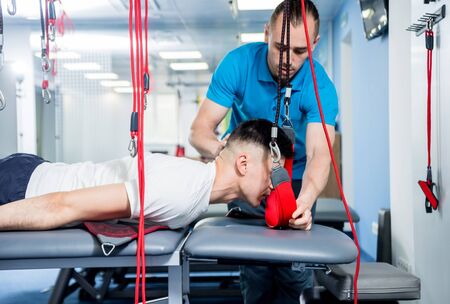Introduction to Ankle Bracing in the UK
Ankle bracing holds a significant place within British physiotherapy, serving as a cornerstone intervention for the management and prevention of ankle injuries. In the UK, physiotherapists frequently encounter patients presenting with ankle sprains, ligamentous instability, or chronic joint weakness—often resulting from sports participation, workplace accidents, or general mobility issues prevalent across all age groups. The use of ankle braces is not only clinically indicated for acute injury management but also for supporting rehabilitation programmes and promoting safe return to activity. Within NHS and private practice settings alike, understanding the latest evidence-based approaches to assessing and fitting ankle braces ensures that practitioners can provide optimal care tailored to each patient’s functional demands and lifestyle. This overview will outline the primary clinical indications for ankle bracing among UK patients and set the stage for a comprehensive exploration of assessment techniques and best fitting practices relevant to contemporary British physiotherapy.
2. Clinical Assessment of the Ankle Joint
Effective assessment of the ankle joint is fundamental for British physiotherapists prior to selecting and fitting an ankle brace. Adhering to best-practice guidelines ensures that any intervention is based on a thorough understanding of the patient’s presentation, injury mechanism, and functional requirements. Below are structured steps and preferred tools used in UK clinical settings for evaluating ankle stability and injury:
Initial Subjective Evaluation
A detailed patient history forms the cornerstone of clinical reasoning. Key aspects include mechanism of injury, previous episodes, current symptoms (pain, swelling, instability), activity level, and occupation. Understanding these factors helps tailor further assessment and informs brace selection.
Objective Examination Protocols
British physiotherapists typically follow a systematic approach encompassing observation, palpation, range of movement (ROM), and specific stability tests. The following table summarises commonly used assessment tools:
| Assessment Tool | Description | Clinical Significance |
|---|---|---|
| Ottawa Ankle Rules | Screening tool to rule out fractures before proceeding with functional testing or bracing | Reduces unnecessary radiographs; widely adopted in NHS practice |
| Anterior Drawer Test | Assesses anterior talofibular ligament integrity by translating the talus forward | Indicates anterior instability; guides brace type selection |
| Talar Tilt Test | Evaluates calcaneofibular ligament by inverting the hindfoot under stress | Reveals lateral ligament laxity; critical for advanced brace fitting |
| Weight-Bearing Lunge Test | Measures dorsiflexion range while weight-bearing against a wall or board | Functional indicator for rehabilitation progress and brace adjustment |
| Proprioception Testing (e.g., Single Leg Balance) | Tests postural control and neuromuscular function on injured side vs. contralateral side | Aids in determining readiness for dynamic bracing or return to sport protocols |
Documentation and Communication Standards
NHS best practice recommends clear documentation using standardised outcome measures such as the Foot and Ankle Disability Index (FADI) or Visual Analogue Scale (VAS) for pain. This facilitates multidisciplinary communication and ensures continuity of care.
Cultural Context: Patient-Centred Care in Britain
In British healthcare culture, it is essential to involve patients in decision-making. Discuss findings openly with your patient, explain the rationale for recommended bracing options, and address any concerns regarding comfort or lifestyle impact. This collaborative approach not only improves compliance but also supports optimal clinical outcomes.

3. Types of Ankle Braces Available in the UK
When recommending or fitting ankle braces, British physiotherapists must be familiar with the range of options accessible within the UK healthcare landscape. This includes understanding the offerings from local brands, those available through the NHS, and products from private suppliers. Each option has its distinct advantages, suitability criteria, and accessibility factors, which can influence clinical decision-making.
Local Brands and Suppliers
The UK market features several reputable local brands such as Neo G, PhysioRoom, and Vulkan. These companies provide a wide selection of ankle supports ranging from basic elasticated sleeves to advanced hinged orthoses. Local brands often tailor their designs to meet the needs and preferences of British patients, offering sizing and support variations suited to common pathologies seen in UK clinical practice. Availability through high street pharmacies or specialist retailers ensures ease of access for both practitioners and patients.
NHS-Available Products
The NHS typically supplies cost-effective and evidence-backed ankle braces for acute injuries or post-surgical rehabilitation. Commonly issued products include tubular compression bandages (e.g., Tubigrip), lace-up braces, and semi-rigid stirrup splints like Aircast or DonJoy models. The selection is guided by national guidelines prioritising patient safety, function, and return-to-activity timelines. Physiotherapists working within NHS trusts should be familiar with their trust’s formulary and referral processes for obtaining these devices.
Private Sector Variations
In private practice settings, there is greater flexibility regarding product choice. Private physiotherapists may recommend premium international brands or custom-fitted orthoses depending on patient needs and budget. Bespoke carbon fibre braces or highly adjustable models are sometimes indicated for complex cases or athletes requiring enhanced support without compromising mobility. The private sector also allows quicker access to newer innovations in brace technology that may not yet be widely adopted within the NHS.
Key Considerations for British Physiotherapists
- Regulatory compliance: Ensure all recommended braces carry appropriate CE marking and adhere to UK safety standards.
- Patient accessibility: Assess whether patients can obtain the brace easily—either via prescription (NHS), over-the-counter (OTC) channels, or online suppliers.
- Cultural preferences: Be mindful of patient expectations regarding comfort, visibility under clothing (especially relevant in school or workplace settings), and ease of use.
Summary
A comprehensive knowledge of ankle brace types available across local brands, NHS provisions, and private sector offerings enables British physiotherapists to make informed recommendations tailored to each patient’s clinical presentation and circumstances. This familiarity supports best practice in assessment, fitting, and ongoing management of ankle injuries within the unique context of UK healthcare delivery.
4. Best Practices for Ankle Brace Fitting
Step-by-Step Guidance for Proper Fitting Procedures
Ensuring the correct fit of an ankle brace is fundamental to achieving comfort, safety, and optimal clinical outcomes for UK patients. The following step-by-step protocol provides practical guidance specifically tailored for British physiotherapists:
1. Initial Assessment
- Review Patient History: Consider the patient’s injury, activity level, and any co-morbidities.
- Evaluate Swelling and Anatomy: Assess for oedema or anatomical variations that may affect brace selection and fit.
2. Selecting the Appropriate Brace
- Type of Injury: Match the brace (e.g., lace-up, rigid, soft support) to the clinical indication (see table below).
- Patient Preferences: Discuss lifestyle factors, such as footwear choices or sport participation common in the UK.
| Brace Type | Indication | Recommended Use |
|---|---|---|
| Lace-up | Mild-moderate sprains | Everyday activities, school PE sessions |
| Rigid/Stirrup | Severe instability/post-operative | Post-injury immobilisation, football recovery |
| Soft Sleeve | Mild support/prevention | Light activity, daily walking in British weather |
3. Sizing and Positioning the Brace Correctly
- Sizing: Measure according to manufacturer’s UK-specific charts. Always check if the patient is wearing appropriate socks or stockings for fitting.
- Anatomical Landmarks: Align brace features (e.g., hinges, straps) with malleoli and Achilles tendon.
- Bilateral Comparison: Compare fit to the contralateral limb to ensure symmetry where possible.
4. Ensuring Comfort and Safety
- No Pressure Points: Check for excessive tightness or rubbing around bony prominences.
- Circulation Check: Monitor capillary refill in toes; ensure no signs of numbness or tingling.
- User Demonstration: Ask the patient to walk or perform functional movements typical in their daily life—such as using public transport or stairs found in UK homes.
Troubleshooting Common Fitting Issues
| Issue Identified | Adjustment Recommendation | UK-Specific Advice |
|---|---|---|
| Pain over malleolus | Add padding or adjust strap tension | Avoid excessive tightness to prevent cold-induced discomfort during winter months |
| Sock slippage under brace | Select moisture-wicking socks with proper grip | Recommend thicker socks for warmth during colder seasons; avoid bunching inside wellies/boots common in UK settings |
| Ineffective support reported by patient | Reassess size and model selection; re-educate on application technique | Create easy-to-follow written instructions using plain English, referencing UK terminology (e.g., trainers instead of sneakers) |
5. Patient Education and Ongoing Management
Culturally Sensitive Communication with British Patients
Effective patient education is an integral aspect of ankle brace management in the UK, requiring physiotherapists to employ culturally sensitive communication strategies. British patients typically value clarity, politeness, and a collaborative approach. It is important to use plain English, avoid medical jargon where possible, and ensure patients feel comfortable asking questions. When discussing assessment findings or fitting procedures, involve the patient in decision-making to foster trust and engagement.
Providing Clear Instructions for Brace Use
Physiotherapists should deliver step-by-step instructions on how to correctly apply, remove, and adjust the ankle brace. Demonstrating these steps during the appointment and providing written or digital handouts using familiar British terminology (such as “trainers” instead of “sneakers”) can improve adherence. Ensure that instructions are concise and practical, accommodating different levels of health literacy and cultural expectations around self-care.
Self-Care Tips Aligned with UK Lifestyle Habits
Advice on self-care must consider typical British routines and activities. Encourage patients to integrate recommended exercises into daily life—such as performing ankle mobility routines while waiting for the kettle to boil or doing balance exercises during TV adverts. Address common weather-related concerns, like walking safely in wet conditions with a brace, and suggest appropriate footwear for various UK climates.
Brace Maintenance: Practical Guidance
Maintenance advice should be tailored to align with local resources and habits. Instruct patients on regular cleaning practices using household items readily available in the UK, such as mild soap and warm water. Remind them to check for signs of wear or damage and direct them to local NHS services or reputable UK suppliers for repairs or replacements if needed.
Ongoing Support and Review
Arrange follow-up appointments either face-to-face or via telephone/video consultation, reflecting the increasing use of digital health services across Britain. Encourage patients to keep a symptom diary or use mobile health apps commonly available through the NHS. Reinforce the importance of communication between patient and physiotherapist throughout the rehabilitation process, ensuring adjustments are made based on individual progress and lifestyle changes.
6. Reflective Practice and Continuing Professional Development
For British physiotherapists, the assessment and fitting of ankle braces does not end with technical proficiency; it is underpinned by a strong commitment to reflective practice and ongoing professional development. The Health and Care Professions Council (HCPC) and the Chartered Society of Physiotherapy (CSP) mandate that all practising physiotherapists in the UK engage in evidence-based practice and demonstrate continual learning throughout their careers.
The Role of Evidence-Based Practice
Implementing ankle bracing interventions requires clinicians to critically appraise current research, guidelines, and clinical outcomes. This approach ensures that recommendations are both effective and tailored to individual patient needs. Physiotherapists should regularly consult reputable sources such as NICE guidelines and peer-reviewed journals to remain abreast of best practices in musculoskeletal care.
Reflective Practice: A Core Professional Value
Reflection is not simply encouraged, but expected within UK physiotherapy culture. After each assessment or fitting, practitioners should evaluate what went well, identify areas for improvement, and consider how their actions align with current evidence. Tools like clinical supervision sessions, peer discussions, and maintaining a reflective diary can support this ongoing process.
Meeting Statutory Requirements
Continuing Professional Development (CPD) is a statutory obligation for all registered UK physiotherapists. Regular participation in CPD activities—such as attending workshops on orthotic management, completing online courses about ankle injuries, or engaging in multidisciplinary team meetings—ensures competence is maintained. Physiotherapists must document their CPD activities, demonstrating compliance during HCPC audits.
Cultivating a Culture of Lifelong Learning
Ultimately, high standards in assessing and fitting ankle braces are sustained through a culture of lifelong learning. By embracing reflective practice and prioritising evidence-based approaches, British physiotherapists can consistently deliver safe, effective care that meets both professional expectations and statutory requirements.


